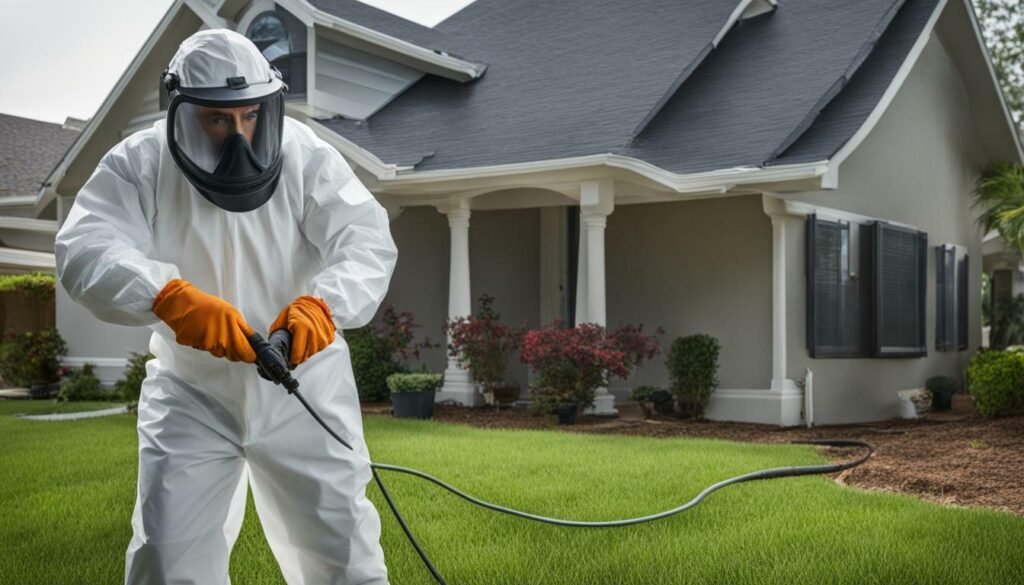Are you ready to eliminate termites from your home? Follow this step-by-step guide to prepare for termite heat treatment.
Key Takeaways:
- Remove plants, pets, and valuables from the treatment area.
- Take out IKEA-type furniture to prevent damage.
- Store perishable foods in the refrigerator.
- Remove items that may be sensitive to heat, such as VHS tapes, vinyl records, candles, and cosmetics.
- Clear the treatment area of wall hangings and lean them against the wall.
- Remove items like alcohol, wine bottles, carbonated beverages, and aerosol cans that can be affected by the heat.
- Protect furniture and belongings from the heat by taking necessary precautions.
- Make essential preparations before the termite heat treatment is performed.
- Follow safety measures and considerations during the treatment process.
- Communicate with the termite exterminator to provide specific details.
Preparing your home for termite heat treatment is crucial in ensuring the success of the extermination process. By following these steps, you can create a safe and effective environment for eliminating termites.
Importance of Termite Control
Termite control is crucial to protect your home from the devastating damage caused by these pests. Termites are silent destroyers, often going unnoticed until significant damage has already been done. They can cause structural damage to your home, including weakening the foundation, walls, and floors. Additionally, termites can chew through wooden furniture, cabinets, and other valuable belongings, leading to costly repairs or replacements.
Termite infestations can go undetected for years, allowing the pests to multiply and wreak havoc on your property. Regular termite control measures, such as inspections and extermination, are essential for early detection and prevention. By addressing termite infestations promptly, you can minimize the risk of extensive damage and reduce the financial burden associated with repairs.
Professional termite inspections can identify signs of infestation and determine the extent of the problem. This information is crucial in developing an effective termite control plan tailored to your specific needs. With proper termite control measures in place, you can safeguard your home, belongings, and investment, ensuring long-term peace of mind.
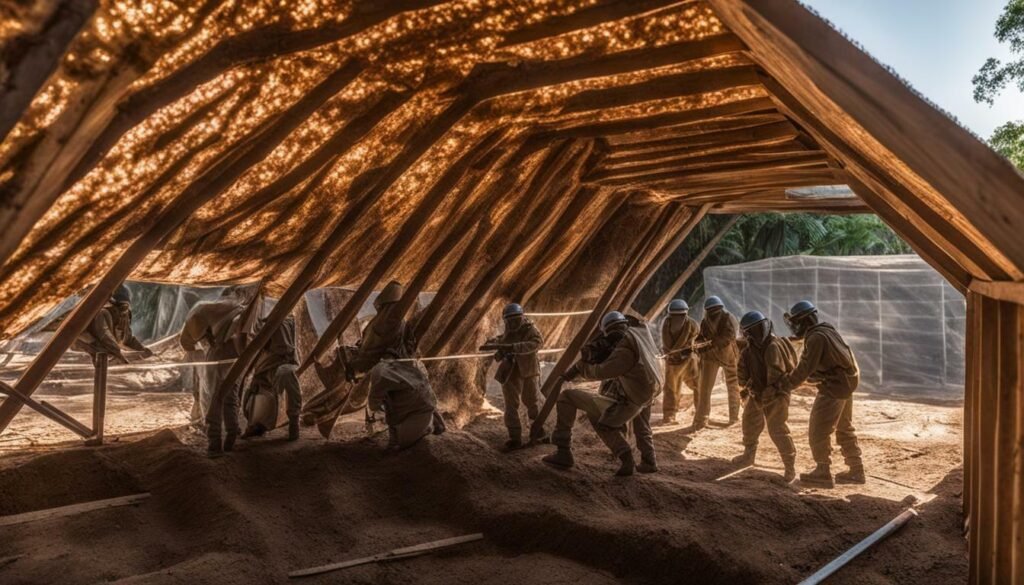

Preventing Termite Infestation
While termite control is essential, prevention is equally important. There are several steps you can take to minimize the risk of termite infestation:
- Maintain proper drainage around your home to prevent excess moisture accumulation.
- Eliminate wood-to-soil contact around the foundation by keeping firewood, mulch, and debris away from the house.
- Seal cracks and gaps in the foundation, walls, and windows to prevent termite entry.
- Regularly inspect wooden structures, including fences, decks, and porches, for signs of termite activity.
- Trim vegetation and trees that are in close proximity to the house to reduce access points for termites.
Professional Termite Control
While DIY termite control methods may provide temporary relief, professional intervention is crucial for effective and long-lasting termite extermination. Pest control experts have the knowledge, experience, and specialized equipment to identify and eliminate termite infestations safely.
Professional termite exterminators can employ various treatment options, including heat treatment, to eradicate termites from your home. These treatments are targeted, environmentally friendly, and ensure the complete elimination of termites, preventing future infestations.
| Benefits of Professional Termite Control | DIY Termite Control Challenges |
|---|---|
| Accurate identification of termite species | Limited knowledge of termite behavior and species identification |
| Safe and effective use of termite control products | Potential misuse of pesticides, leading to health and safety risks |
| Comprehensive termite inspections and treatment plans | Superficial inspections and inadequate treatment methods |
| Long-term prevention strategies | Lack of expertise in implementing preventive measures |
By investing in professional termite control services, you are taking proactive steps to protect your home from the destructive forces of termites. Regular inspections and treatments will help ensure that your property remains termite-free, preserving its value and integrity for years to come.
Understanding Termite Heat Treatment
Termite heat treatment is a popular method used by professional exterminators to eliminate termite infestations. This highly effective treatment involves raising the temperature of the infested area to a level that is lethal to termites, effectively eradicating the problem. By using high-powered heaters and specialized equipment, the heat treatment penetrates walls, cracks, and crevices, targeting termites in even the most hard-to-reach areas.
One of the advantages of termite heat treatment is that it is a non-chemical solution, making it safe for both humans and pets. It is also an environmentally friendly option, as it does not release any harmful toxins into the air or soil. Another benefit of heat treatment is its ability to reach every nook and cranny of a property, ensuring that all termites are exterminated, including their eggs and larvae.
Preparing for Termite Heat Treatment
Prior to the termite heat treatment, there are several important steps that need to be taken to ensure its success. These preparations are crucial in maximizing the effectiveness of the treatment and minimizing any potential risks. Here are some key points to consider when preparing for termite heat treatment:
- Remove all plants and pets from the treatment area: To protect them from the high temperatures.
- Take out IKEA-type furniture: Heat may cause de-lamination, so it’s best to remove this type of furniture from the treatment area.
- Place perishable foods in the refrigerator: The heat treatment may affect the quality and safety of food items, so it’s advisable to store them in the refrigerator during the treatment process.
- Remove items that are sensitive to heat: This includes VHS tapes, vinyl records, candles, cosmetics, and medicines, as they may be damaged or altered by the high temperatures.
- Clear the treatment area: Remove wall hangings and lean them against the wall, and take out alcohol, wine bottles, carbonated beverages, aerosol cans, lighters, ammunition, drain water beds/furniture, de-flate bike tires and air mattresses, remove CO2 cartridges/combustibles, oil paintings, crayons, and musical instruments.
By following these preparation steps, you can ensure that your home is ready for termite heat treatment and optimize the results of the extermination process.
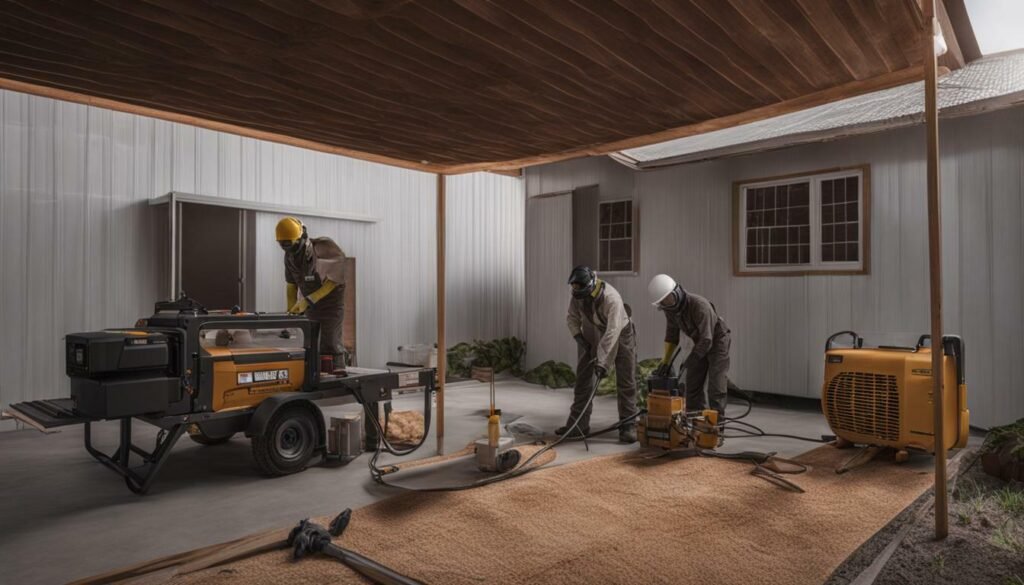

Preparing Your Home for Termite Heat Treatment
Before the termite exterminator arrives, it’s important to properly prepare your home for the heat treatment process. Termite heat treatment is a highly effective method for exterminating termites and preventing further infestations. By following these steps, you can ensure that the treatment is successful and minimize any potential damage to your belongings.
First, remove all plants and pets from the treatment area. The high temperatures used in termite heat treatment can be harmful to plants and animals, so it’s crucial to relocate them to a safe area during the process.
Next, take out any IKEA-type furniture as the heat may cause de-lamination. These types of furniture are more prone to damage from the elevated temperatures, so it’s best to temporarily remove them from the treatment area to prevent any issues.
To protect perishable foods from the heat, place them in the refrigerator. This will prevent them from spoiling during the treatment process. Additionally, remove items such as VHS tapes, vinyl records, candles, cosmetics, and medicines from the treatment area, as they can also be affected by the high temperatures.
It’s important to remove wall hangings and lean them against the wall during termite heat treatment. This allows for better heat circulation and ensures that all areas are thoroughly treated. Additionally, take out any items such as alcohol, wine bottles, carbonated beverages, aerosol cans, lighters, ammunition, drain water beds/furniture, deflate bike tires and air mattresses, remove CO2 cartridges/combustibles, oil paintings, crayons, and musical instruments as they may be sensitive to heat.
Remember to remove valuables and fish tanks from the treatment area to keep them safe. Valuables can be relocated to a secure location within your home, while fish tanks should be taken to a safe area to prevent any harm to the fish.
Finally, ensure that there is a parking space in front of your home that is at least 22 feet long. This is necessary for the termite exterminator to set up the equipment required for the heat treatment process.
By following these steps and properly preparing your home for termite heat treatment, you can ensure the best results and protect your belongings from potential damage. Remember, these steps may vary depending on the specific company and treatment method used, so it’s essential to follow the instructions provided by your termite exterminator.
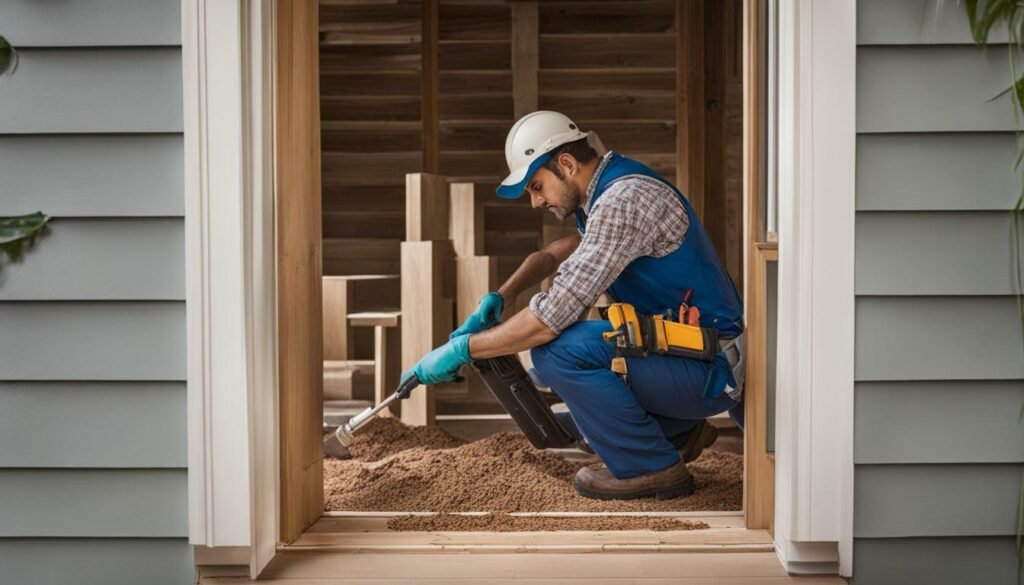

| Preparation Steps: |
|---|
| Remove plants and pets from the treatment area |
| Take out IKEA-type furniture |
| Place perishable foods in the refrigerator |
| Remove VHS tapes, vinyl records, candles, cosmetics, and medicines |
| Remove wall hangings and lean them against the wall |
| Take out alcohol, wine bottles, carbonated beverages, aerosol cans, lighters, ammunition, drain water beds/furniture, deflate bike tires and air mattresses, remove CO2 cartridges/combustibles, oil paintings, crayons, and musical instruments |
| Remove valuables and fish tanks |
| Ensure a parking space in front of the home |
Clearing the Treatment Area
Start by removing all plants and pets from the area that will be treated for termites. This is important to ensure their safety and prevent any harm or discomfort during the heat treatment process. Plants can be temporarily relocated to a different area of your home or placed outside, away from the treatment area. Pets should be kept in a separate room or taken to a friend or family member’s house until the treatment is complete.
Next, take out any IKEA-type furniture from the treatment area. These pieces of furniture are often made with laminated materials that can delaminate under high temperatures. It is best to remove them to avoid any potential damage during the termite heat treatment.
Additionally, perishable foods should be placed in the refrigerator to prevent heat exposure. Items such as VHS tapes, vinyl records, candles, cosmetics, and medicines should also be removed from the treatment area. These items can be sensitive to high temperatures and may be damaged during the termite heat treatment process.


When clearing the treatment area, it is essential to remove wall hangings and lean them against the wall. This allows for efficient heat distribution and helps protect these items from potential damage. As for items like alcohol, wine bottles, carbonated beverages, aerosol cans, lighters, ammunition, drain water beds/furniture, deflate bike tires and air mattresses, remove CO2 cartridges/combustibles, oil paintings, crayons, and musical instruments, it is advised to take them out of the treatment area to prevent any potential harm.
Remember to remove valuables and fish tanks from the treatment area as well. Valuables can be kept in a safe location within your home, away from the treatment area, to ensure their protection. Fish tanks should also be relocated to a safe place to avoid any stress or harm to the fish during the termite heat treatment process.
By following these steps and clearing the treatment area, you are taking the necessary precautions to ensure the effectiveness of the termite heat treatment and protect your belongings. Make sure to comply with the guidelines provided by your termite exterminator and notify them of any specific details regarding your home or treatment area.
Protecting Furniture and Belongings
Take precautions to prevent any potential damage to your furniture and belongings during the termite heat treatment process. Here are some essential steps to follow:
- Move furniture and belongings at least 3 feet away from walls to allow for proper airflow during treatment.
- Remove items hanging on the walls and stack lampshades on the floor to protect them from heat exposure.
- Turn over rubber-backed rugs and remove foam rubber mats, as these can be damaged by the increased temperatures.
- Loosely fill drawers and linen closets to ensure proper heat circulation.
- Remove items off the floor in closets to prevent any direct heat contact.
- Leave clothes hanging in closets, but make sure they are spaced apart to allow heat to reach all areas.
- Drain water beds and deflate air beds to avoid potential damage due to temperature fluctuations.
- Wrap impractical articles in insulating material and place small items in the refrigerator for added protection.
By following these guidelines, you can safeguard your furniture and belongings during the termite heat treatment process. It is essential to take these precautions to ensure the effectiveness of the treatment while minimizing any potential damage.
Expert Tip:
Consider hiring professional movers to assist with the process of moving heavy furniture and delicate items. They have experience in handling and protecting belongings during treatment.
| Items to Remove from Treatment Area | Items to Protect During Treatment | Items to Relocate or Secure |
|---|---|---|
| Plants and pets | Furniture | Valuables |
| VHS tapes, vinyl records, candles, cosmetics, and medicines | Wall hangings | Firearms and ammunition |
| Alcohol, wine bottles, carbonated beverages, aerosol cans, lighters, drain water beds/furniture, de-flate bike tires and air mattresses, remove CO2 cartridges/combustibles, oil paintings, crayons, and musical instruments | Lampshades | Antique furniture with finishes or fragile glue points |
Understanding which items to remove, protect, or relocate will contribute to a successful termite heat treatment process. Keep in mind that these steps may vary depending on the specific company and treatment method used.


Essential Preparations for Termite Heat Treatment
There are several important steps you should follow to ensure the success of the termite heat treatment process. Taking the necessary precautions and making thorough preparations will help maximize the effectiveness of the treatment and minimize any potential risks. Here is a detailed guide on how to prepare your home for termite heat treatment:
- Remove all plants and pets from the treatment area to protect them from the heat and chemicals used in the process.
- Take out IKEA-type furniture that has laminated surfaces, as the heat may cause delamination.
- Place any perishable foods in the refrigerator to keep them safe during the treatment.
- Remove items such as VHS tapes, vinyl records, candles, cosmetics, and medicines from the treatment area.
- Take down wall hangings and lean them against the wall to ensure they are not damaged during the treatment.
It is also important to remove any alcohol, wine bottles, carbonated beverages, aerosol cans, lighters, ammunition, and drain water from beds and furniture. Additionally, deflate bike tires and air mattresses, remove CO2 cartridges and other combustibles, oil paintings, crayons, and musical instruments. Valuables and fish tanks should be relocated to a safe place outside the treatment area.
Make sure there is a parking space in front of your home that is at least 22 feet long to accommodate the heat treatment equipment. Drain and cap fire sprinkler systems and put them in test mode, ensuring they do not interfere with the treatment process.
Remember to communicate with the termite exterminator about any specific details regarding fire sprinklers, heat sensors, vinyl windows, laminate/vinyl wallpaper or siding in your home. Having a spare set of clothing sealed in a plastic bag and arranging alternative accommodation during the treatment period is also recommended.
| Preparations | Key Points |
|---|---|
| Remove plants and pets | Protect them from heat and chemicals |
| Take out IKEA-type furniture | Heat may cause delamination |
| Place perishable foods in the refrigerator | Ensure their safety during treatment |
| Remove VHS tapes, vinyl records, candles, cosmetics, and medicines | Protect them from the treatment process |
| Remove wall hangings | Lean them against the wall to prevent damage |
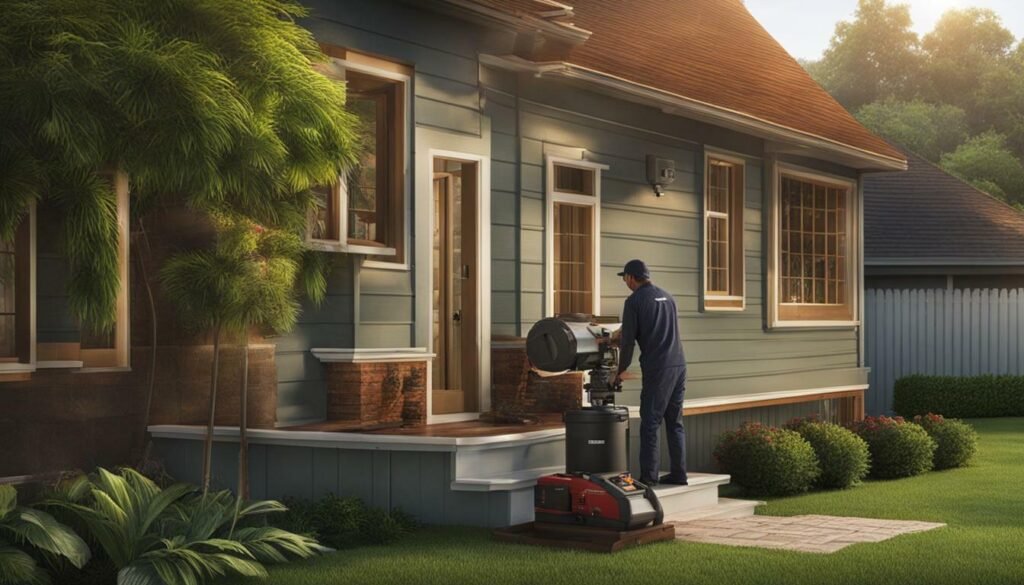

By following these essential preparations, you can help ensure the effectiveness of the termite heat treatment while safeguarding your belongings and the well-being of your family and pets.
Safety Measures and Considerations
Ensuring safety during termite heat treatment is crucial for both you and the exterminator. This process involves raising the temperature in your home to exterminate termites, which can pose certain risks. By following these safety measures and considerations, you can help to minimize any potential hazards:
Carefully remove plants and pets from the treatment area
Before the termite heat treatment begins, it’s important to relocate any plants or pets from the affected areas. The high temperatures used during the treatment can be harmful to living organisms, so it’s best to keep them in a safe and separate location until the process is complete.
Prepare your home and belongings
In order to protect your furniture and other belongings, it’s advisable to take certain precautions. Remove any items that may be sensitive to heat, such as VHS tapes, vinyl records, candles, cosmetics, and medicines. Additionally, wall hangings should be taken down and leaned against the wall, while valuables and fish tanks should be temporarily relocated.
Remember to also remove any combustible items, such as alcohol, aerosol cans, lighters, ammunition, and CO2 cartridges. Taking these steps will help to ensure that your home and belongings are safeguarded during the termite heat treatment process.
“Ensuring safety during termite heat treatment is crucial for both you and the exterminator.”
Clear access and communicate with the exterminator
It’s important to provide clear access to all areas of your home that require treatment. Make sure that there is a parking space available in front of your home to accommodate the exterminator’s equipment. Additionally, inform the company about any specific features of your home, such as fire sprinkler systems, heat sensors, or vinyl windows. This will allow the exterminator to adapt the treatment process accordingly.
Communication with the termite exterminator is key throughout the preparation and treatment stages. Be sure to inform them of any concerns or questions you may have, and follow their instructions regarding safety measures and guidelines. Working together will ensure a successful and safe termite heat treatment process.
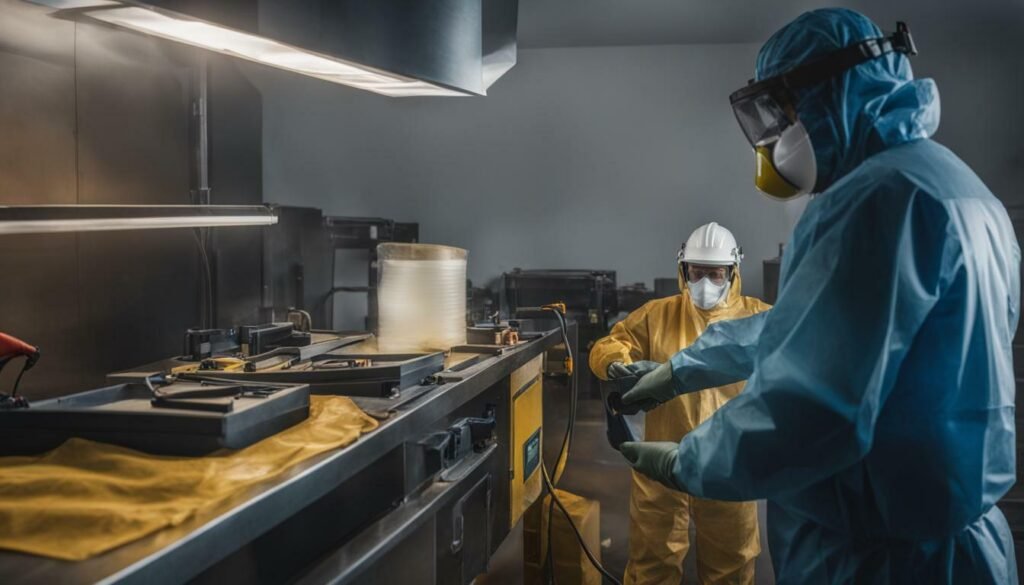

By adhering to these safety measures and considerations, you can help to create a secure environment for both you and the termite exterminator during the heat treatment process. Remember, every precaution taken contributes to the effective eradication of termites from your home.
Communication with the Termite Exterminator
Open and clear communication with the termite exterminator is essential for a successful heat treatment preparation. Before the treatment begins, it is crucial to discuss any specific details or concerns you may have. This will ensure that the exterminator can tailor the treatment plan to meet your needs and address any unique circumstances in your home.
During the initial consultation, provide the exterminator with as much information as possible. This includes any previous termite infestations, the extent of the current infestation, and any structural or environmental factors that may impact the treatment. The more information you provide, the better equipped the exterminator will be to develop an effective plan of action.
Don’t hesitate to ask questions or seek clarification on any aspects of the heat treatment process. Understanding what will happen during the treatment and what steps you need to take will help you prepare adequately. The exterminator can also provide guidance on post-treatment precautions and monitoring to ensure long-term termite prevention.
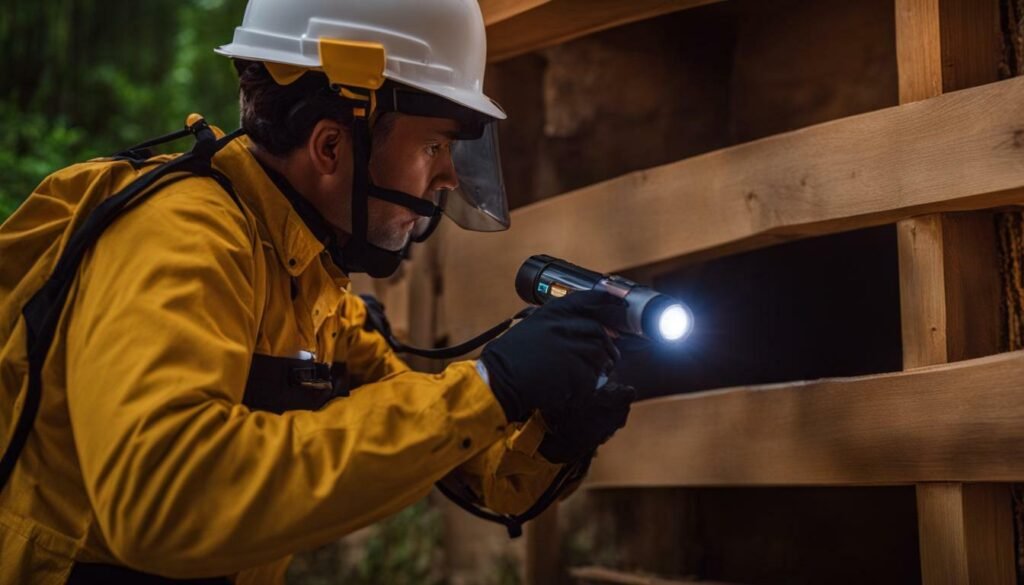

| Key Points for Communication: |
|---|
| Provide detailed information about previous infestations and current circumstances |
| Ask questions and seek clarification on the treatment process |
| Discuss post-treatment precautions and long-term prevention strategies |
Remember, effective termite control requires collaboration between you and the termite exterminator. By maintaining open lines of communication, you can ensure that the preparation and treatment process goes smoothly, leading to successful termite extermination and long-term prevention in your home.
Final Steps Before Termite Heat Treatment
Ensure that you have completed all the necessary preparations before the termite heat treatment begins. Following these final steps will help ensure a smooth and effective treatment process.
Clearing the Treatment Area
Start by removing all plants and pets from the treatment area. This will help protect them from the heat and chemicals used during the treatment process. Additionally, take out any IKEA-type furniture, as the heat may cause de-lamination.
Protecting Furniture and Belongings
Next, take measures to safeguard your furniture and belongings. Place perishable foods in the refrigerator to prevent them from being affected by the heat. Remove VHS tapes, vinyl records, candles, cosmetics, and medicines from the treatment area. This will help protect these items from potential damage.
Note: These steps may vary depending on the specific company and treatment method used.
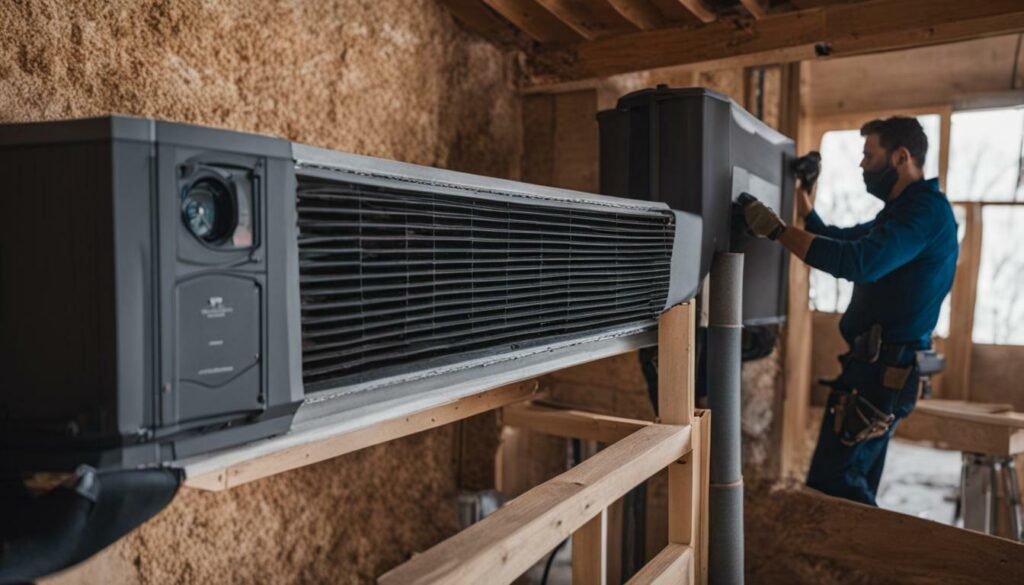

What to Expect During Termite Heat Treatment
Understanding what will happen during termite heat treatment can help alleviate any concerns or uncertainties. This highly effective method of termite extermination involves raising the temperature of the affected area to a level that is lethal to termites. Here is a step-by-step breakdown of what you can expect during the termite heat treatment process:
- First, all plants and pets must be removed from the treatment area to ensure their safety.
- The heat generated during the treatment may cause de-lamination in IKEA-type furniture, so it is advisable to take them out of the area.
- Perishable foods should be placed in the refrigerator to prevent any damage or spoilage.
- VHS tapes, vinyl records, candles, cosmetics, and medicines should be removed as they may be sensitive to high temperatures.
- Wall hangings should be taken down and leaned against the wall to protect them from the heat.
These are just a few of the initial steps involved in preparing your home for termite heat treatment. It is important to follow the instructions provided by your termite exterminator to ensure the success of the treatment.


During the treatment, it is recommended to stay away from the home until the fumigation is complete. Once the treatment is finished, you can expect a thorough inspection of the treated area to ensure that all termites have been eliminated. Your termite exterminator will provide you with further instructions on how to proceed after the treatment, such as ventilating the area and cleaning up any residual debris.
Remember, these steps may vary depending on the specific company and treatment method used. It is always best to consult with a professional termite exterminator who can provide you with the most accurate and up-to-date information for your specific situation.
Conclusion
Proper termite heat treatment preparation is crucial for a successful extermination and a termite-free home. By following the step-by-step guide provided in this article, you can effectively prepare your home and ensure the best possible outcome for termite control.
During the preparation process, it is important to remove all plants and pets from the treatment area to protect them from the heat. Additionally, taking out IKEA-type furniture is recommended as the high temperatures may cause de-lamination. Placing perishable foods in the refrigerator, removing certain items such as VHS tapes and vinyl records, and clearing the treatment area are all essential steps to prepare your home for termite heat treatment.
Protecting your furniture and belongings is also a crucial aspect of termite heat treatment preparation. This involves removing valuables, fish tanks, and items that may be sensitive to heat. Taking safety measures such as draining water beds and deflating air beds, as well as turning over rugs and removing foam rubber mats, will help safeguard your possessions during the treatment process.
Lastly, effective communication with the termite exterminator is paramount. Informing them about specific details such as fire sprinklers, heat sensors, vinyl windows, and other factors will enable them to tailor the treatment to your home’s unique needs.
By adhering to these preparations and staying informed about the termite heat treatment process, you can create a safe and effective environment for extermination. Remember to follow the guidelines provided by your chosen company, as the specific steps may vary depending on the treatment method used. With proper preparation, you can achieve a termite-free home and protect your property from the damaging effects of termite infestation.
FAQ
Q: Can I leave my plants and pets in the treatment area during termite heat treatment?
A: No, it is important to remove all plants and pets from the treatment area to ensure their safety.
Q: Do I need to remove all furniture from the treatment area?
A: While some furniture may need to be removed, specifically IKEA-type furniture as heat may cause de-lamination, it is best to consult with the termite exterminator for specific instructions.
Q: What should I do with perishable foods during termite heat treatment?
A: Perishable foods should be placed in the refrigerator to prevent any potential damage from the heat treatment.
Q: Are there any items I need to remove from the treatment area?
A: Yes, it is important to remove VHS tapes, vinyl records, candles, cosmetics, medicines, wall hangings, alcohol, wine bottles, carbonated beverages, aerosol cans, lighters, ammunition, drain water beds/furniture, de-flate bike tires and air mattresses, remove CO2 cartridges/combustibles, oil paintings, crayons, and musical instruments from the treatment area.
Q: Do I need to remove valuables during termite heat treatment?
A: Yes, it is best to remove valuables and fish tanks from the treatment area to prevent any potential damage.
Q: Should I remove shoes with glue down soles?
A: Yes, shoes with glue down soles should be removed as the heat treatment may cause them to separate.
Q: Should I leave everything in the home during termite heat treatment?
A: Yes, with the exception of the listed items that need to be removed, it is important to leave everything else in the home during the treatment.
Q: How far should I move furniture and belongings from the walls?
A: Furniture and belongings should be moved at least 3 feet away from the walls to allow for effective heat distribution.
Q: What should I do with items on the walls and lampshades?
A: Items on the walls should be removed and lampshades should be stacked on the floor.
Q: Do I need to remove items from closets?
A: While items off the floor in closets should be removed, clothes can be left hanging in closets, spaced apart.
Q: Should I drain water beds and deflate air beds?
A: Yes, water beds should be drained and air beds should be deflated to avoid any potential damage during the heat treatment.
Q: Should I remove electric wall socket covers?
A: Yes, electric wall socket covers should be removed to provide pesticide access.
Q: What should I do if I have fire sprinklers, heat sensors, vinyl windows, laminate/vinyl wallpaper or siding?
A: It is important to notify the company of these specific details so that they can make necessary accommodations during the termite heat treatment.
Q: What items should I seal in a plastic bag?
A: It is recommended to have a spare set of clothing sealed in a plastic bag for easy access during the termite heat treatment.
Q: Should I make arrangements to stay elsewhere during termite heat treatment?
A: Yes, it is advisable to have somewhere to stay during the treatment process to ensure your safety and comfort.
Q: Are there any specific items I need to remove from the treatment area apart from what was already mentioned?
A: Yes, it is important to remove people, pets, plants, candles, wax, crayons, lipstick, medicines, vitamins, aerosol cans, firearms, ammunition, oil paintings, fresh fruit and vegetables, chocolates, carbonated beverages, wines, liquors, antique furniture with finishes or fragile glue points, and heat-sensitive musical instruments and collectibles from the treatment area.
Q: What should I do with impractical articles and small items?
A: Impractical articles should be wrapped in insulating material and small items can be placed in the refrigerator for safekeeping during the termite heat treatment.
Q: Do I need to remove all food, animal feed, drugs, and medications?
A: Yes, it is important to remove all food, animal feed, drugs, and medications from the treatment area to avoid any potential damage or contamination.
Q: Should I remove fish from fish tanks?
A: Yes, fish should be removed from fish tanks and kept in a safe environment during the termite heat treatment.
Q: What should I do with doors, blinds, and drapes?
A: All doors between rooms and cabinets, closets, appliances, attic, and basement should be left open. Blinds should be raised and drapes on windows should be opened.
Q: Should I move gravel or mulch from the foundation?
A: Yes, it is recommended to rake back gravel or mulch from the foundation to allow for proper heat circulation during the treatment.
Q: Should I remove or lower antennae, weathervanes, chimney stacks, and mechanical awnings?
A: Yes, it is best to remove or lower antennae, weathervanes, chimney stacks, and mechanical awnings to prevent any potential damage during the termite heat treatment.
Q: Do I need to clear access to closets, storage rooms, and crawl spaces?
A: Yes, it is important to clear access to closets, storage rooms, and crawl spaces to ensure the termite exterminators can perform the treatment effectively.
Q: Should I turn off heat sources and unplug appliances?
A: Yes, heat sources should be turned off and appliances should be unplugged to prevent any potential issues during the termite heat treatment.
Q: Should I leave keys for the fumigator?
A: Yes, it is important to leave keys for the fumigator to allow them access to the treatment area.
Q: Can I stay in my home during termite heat treatment?
A: No, it is recommended to stay away from the home until the termite heat treatment is complete to ensure your safety and allow the treatment to be carried out effectively.
Source Links
- http://mccloudservices.com/wp-content/uploads/2013/04/HEAT-TREATMENT-CLIENT-PREPARATION-CHECKLIST-02-2013.pdf
- https://www.terminix.com/blog/diy/how-to-prepare-for-fumigation/
- https://www.trueheatsolutions.com/wp-content/uploads/2018/12/Termite-Heat-Prep-Sheet-2019.pdf
Your Expert in Animal Control and Extermination. Trust our experience for humane, effective pest management, protecting your property and ensuring peace of mind with Michael S.

